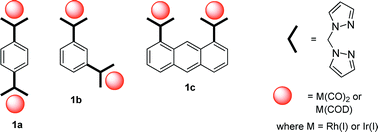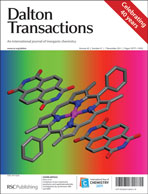The synthesis of a series of Rh(I) and Ir(I) homobimetallic complexes using three different linking scaffolds is described. The cyclooctadiene (COD) complexes [M2(COD)2(Lscaffold)][BArF4]2 (2–7) where M = Rh(I) or Ir(I), and Lscaffold = bis(1-pyrazolyl)methane ligands, p-C6H4[CH(pz)2]2 (1a), m-C6H4[CH(pz)2]2 (1b) and the anthracene-bridged 1,8-C14H8[CH(pz)2]2 (1c) were synthesized. The COD co-ligands of 2–7 were replaced with the carbonyl co-ligands to form the analogous homobimetallic complexes, [M2(CO)4(Lscaffold)][BArF4]2 (8–13). The solid-state structures of the dicationic homobimetallic complexes 2, 3, 5, 6, 9, and 10, as well as cationic monometallic complexes 15 and 22 of ligands 1b and 1c respectively, were characterized using X-ray crystallography. The solid-state XRD structures of the resulting dirhodium and diiridium complexes with the para- and meta-phenylene and anthracene scaffolds show that there are distinct differences between structures of complexes 2–10 due to the variation in the scaffold structures, in particular the relative positions of the two metal centres. Heterobimetallic RhIr complexes of the m-C6H4[CH(pz)2]2 ligand were also synthesized using a stepwise approach, and the observed exchange of the metal centres in the heterobimetallic complexes was found to be dependent on the nature of the coligand.

You have access to this article
 Please wait while we load your content...
Something went wrong. Try again?
Please wait while we load your content...
Something went wrong. Try again?


 Please wait while we load your content...
Please wait while we load your content...